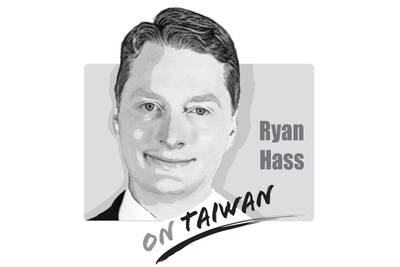Details of recent unrest in Xinjiang will never fully come to light. Like the Tibetan riots last year, the Gulja massacre 12 years earlier or the violence at Tiananmen two decades ago, there will be no public probe to establish the truth of events, and wounds festering in private will not heal.
But long after this summer’s riots, the lingering impression will be that Beijing’s talk of ethnic harmony and national unity is hollow, while discontent with its authoritarian rule is strong.
For this, Beijing has itself to blame. It remains unwilling — in public at least — to acknowledge the legitimacy of the Uighurs’ complaints. Rather than recognizing systematic economic discrimination and repealing government policies that are crushing the language, religion and other aspects of Uighur culture, Beijing has stepped up its “war on terror” rhetoric.
Having learned nothing from its failed campaign to label the Dalai Lama a “terrorist,” China has intensified its invective against exiled Uighur leader Rebiya Kadeer.
The strategy has been another public-relations disaster for China, underscoring its thuggishness and alienating it further from the human rights agendas of Western countries. Judging from statements about Kadeer made by senior Chinese officials to foreign media, Beijing has yet to understand that rhetoric that works well at home to whip up nationalist anger is counterproductive in democratic countries.
Beijing is, if anything, fueling Kadeer’s fame and expanding her audience. By dogging her wherever she goes, Beijing ensures there is plenty of media interest before Kadeer even steps off the plane.
Kadeer’s arrival in Japan yesterday received more attention from the media as a result of Beijing’s protest to Tokyo over the visit.
Likewise, a documentary about Kadeer that might otherwise have attracted little attention has become the focus of an international discussion on Beijing’s campaign against Kadeer and its treatment of Uighurs. A screening of the documentary sold out at a Melbourne film festival that, thanks to Beijing’s pressure to pull the film, had to schedule an extra screening to accommodate public interest.
Today, very few people have heard of Gulja or the events that took place in Xinjiang in February 1997, when China sent in troops to silence street protests for economic equality, religious freedom and other fundamental rights. The blood that was shed launched Kadeer on a quest to determine who was responsible. Her questions quickly undermined her status as a darling of Beijing and eventually her efforts to highlight injustices in Xinjiang landed her in prison. The violence in Gulja remains a subject as forbidden as the events of June 4, 1989.
But Kadeer understood something that Beijing didn’t: Probing the Gulja crackdown was in its interest. Only by recognizing wrongs and addressing the causes of Uighur resentment can stability be realized.
Today, she is only one of many well-educated and articulate Uighurs leading a campaign for human rights in exile, many of whom were once loyal members of the Chinese Communist Party.
With these voices scattered in Europe and North America, the complaints of Uighurs are gaining sympathy and prominence. Beijing’s campaign to label the peaceful activities of Uighurs abroad as “terrorism” will only lend credence to their cries of oppression.
The events of Gulja may never be addressed, but the reaction to recent unrest in Xinjiang shows Beijing’s propaganda efforts have failed. Gone are the days when China could send in the military to bludgeon opposition and count on little attention from abroad.

There has been much catastrophizing in Taiwan recently about America becoming more unreliable as a bulwark against Chinese pressure. Some of this has been sparked by debates in Washington about whether the United States should defend Taiwan in event of conflict. There also were understandable anxieties about whether President Trump would sacrifice Taiwan’s interests for a trade deal when he sat down with President Xi (習近平) in late October. On top of that, Taiwan’s opposition political leaders have sought to score political points by attacking the Lai (賴清德) administration for mishandling relations with the United States. Part of this budding anxiety
The diplomatic dispute between China and Japan over Japanese Prime Minister Sanae Takaichi’s comments in the Japanese Diet continues to escalate. In a letter to UN Secretary-General Antonio Guterres, China’s UN Ambassador Fu Cong (傅聰) wrote that, “if Japan dares to attempt an armed intervention in the cross-Strait situation, it would be an act of aggression.” There was no indication that Fu was aware of the irony implicit in the complaint. Until this point, Beijing had limited its remonstrations to diplomatic summonses and weaponization of economic levers, such as banning Japanese seafood imports, discouraging Chinese from traveling to Japan or issuing
The diplomatic spat between China and Japan over comments Japanese Prime Minister Sanae Takaichi made on Nov. 7 continues to worsen. Beijing is angry about Takaichi’s remarks that military force used against Taiwan by the Chinese People’s Liberation Army (PLA) could constitute a “survival-threatening situation” necessitating the involvement of the Japanese Self-Defense Forces. Rather than trying to reduce tensions, Beijing is looking to leverage the situation to its advantage in action and rhetoric. On Saturday last week, four armed China Coast Guard vessels sailed around the Japanese-controlled Diaoyutai Islands (釣魚台), known to Japan as the Senkakus. On Friday, in what
On Nov. 8, newly elected Chinese Nationalist Party (KMT) Chairwoman Cheng Li-wun (鄭麗文) and Vice Chairman Chi Lin-len (季麟連) attended a memorial for White Terror era victims, during which convicted Chinese Communist Party (CCP) spies such as Wu Shi (吳石) were also honored. Cheng’s participation in the ceremony, which she said was part of her efforts to promote cross-strait reconciliation, has trapped herself and her party into the KMT’s dark past, and risks putting the party back on its old disastrous road. Wu, a lieutenant general who was the Ministry of National Defense’s deputy chief of the general staff, was recruited